
We sometimes build tactical, varmint and target rifles in the shop as the subject of articles. Heavy weights with long barrels, intended to shoot accurately at extended ranges. Typically the small bore rifles are based on the 22-250 Remington and rifles requiring a bit more down range are often based on the 308 Winchester or the 300 Winchester Magnum as an extreme. The Weatherby Mark V® TRR RC, chambered for the 338-378 Weatherby Magnum, takes things to another level. Pictured above, the 338-378 Weatherby Magnum next to a 308 Winchester cartridge for comparison.
The Weatherby Mark V® TRR RC broadly defined

|
||||||||||||||||||||||||||||||||||||||||||||
Some things that exemplify this version of the Mark V are a cut rifled 26″ Krieger barrel for best accuracy and a hand honed action for full nine lug engagement. The hand laminated stock has an integral CNC 6061 T-6 aluminum bedding system and a 3-position buttstock – adjustable for LOP, drop at heel and cant. The stock has a #6 forearm slide to facilitate use of a bipod.
This particular model is Range Certified which means the individual rifle has demonstrated sub MOA accuracy capability. The subject rifle was factory range tested and shipped with supporting data in the form of a target, range session environmental data and ammunition specifics. This is useful information to assure guaranteed sub MOA performance.
A little closer look…
Below – The TRR RC has an oversize tactical style bolt handle to facilitate ease of use even with gloved hands. The safety is within easy reach and has two positions, on and off. The bolt is locked on safe.
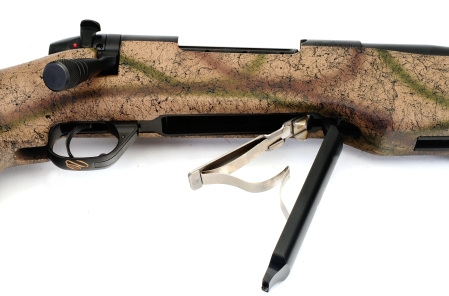
The bottom metal is cleanly finished lightweight, but strong, matte black aluminum. Where the Mark V Accumark Model has 2 round magazine capacity with this cartridge, the TRR RC’s floorplate is dropped and hollowed to expand this to a three shot capacity. The internal magazine box keeps ammunition properly aligned and assures smooth center feed. The rear of the bipod slot is visible on the forearm.
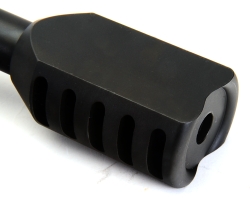
Unlike the more familiar Weatherby cylindrical Accubrake™. The Weatherby Mark V TRR RC’s tactical muzzle brake is flat and solid, top and bottom. The large volume ports vent to the sides only, a design typically found on high gas volume 50 BMG guns. The familiar Accubrake™ is still utilized on the TRR Custom Magnum, one step down in the Mark V TRR lineup.
In use, the brake makes for different shooting characteristics than the Accubrake™. Muzzle blast seems a bit more, however, there is less of a pressure wave and less recoil. The barrel lays down flat after discharge making a second shot faster than the slightly more muzzle climbing result of the Accubrake™. They are both effective brakes that really take the edge off of a heavy recoiling rifle. The tactical brake and barrel are indexed to assure proper alignment and locked in place with a set screw. A thread protector is packaged with the rifle for use when the rifle is in service with the brake removed.
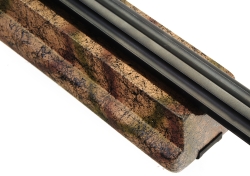
Very thoughtful of Weatherby to make this one in black moly rather than in bright stainless. I’ve had a couple of TAC rifles in the shop from other manufacturers and I am always surprised that they did not see the downside of a high reflective rifle intended for this mission. The Weatherby’s finish is matte and very uniform.
The barrel is floated in the stock with an 1/8″ barreled contoured clearance all the way us the barrel channel to the recoil lug. With the stock’s aluminum frame securing the action, there isn’t a need to fiddle with a closer barrel fit or glass bedding, with the exception of the glass bedded recoil lug.
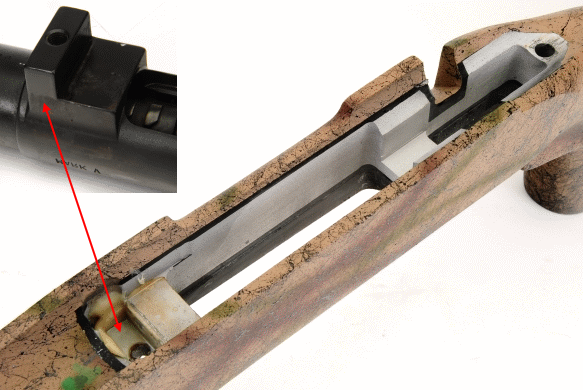
Characteristically Mark V
The big push feed Weatherby Mark V’s (far left) bolt body is the same diameter as its locking lugs for maximum columnar strength. The push feed Remington (center) has a reduced size bolt body, as does the controlled feed Winchester Model 70 at the far right. Notice the Weatherby and Remington bolt faces project forward of their lugs. In both, the bolt face contains the cartridge case head and recesses into the barrel, totally containing the cartridge. If you measure the Weatherby’s nine smaller lugs you’ll find there is more contact surface than the large two lug systems.

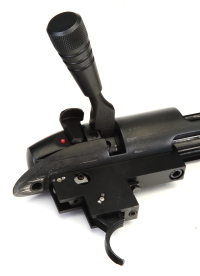 As noted previously, this particular rifle is assembled with a hand honed action to assure smooth operation and full engagement of all intended contact surfaces. This interrupted screw design lock up has been proven time and time again for its strength and speed, starting in 1875. The higher lug count adds to strength while the tri-set interrupted thread requires only 54° of rotation to lock and unlock. The hinged mounting of the extractor puts it on the outside diameter of the bolt head, rather than inside the bolt face, which gives added cartridge diameter capacity.
As noted previously, this particular rifle is assembled with a hand honed action to assure smooth operation and full engagement of all intended contact surfaces. This interrupted screw design lock up has been proven time and time again for its strength and speed, starting in 1875. The higher lug count adds to strength while the tri-set interrupted thread requires only 54° of rotation to lock and unlock. The hinged mounting of the extractor puts it on the outside diameter of the bolt head, rather than inside the bolt face, which gives added cartridge diameter capacity.
The Weatherby Mark V TRR RC is equipped with a hand-tuned, fully adjustable trigger. The trigger is factory preset at a minimal 3 lbs with a sear engagement of .008″ to .014″. This particular rifle scale checked at 3 pounds 9 ounces of pull, however, a swing through the trigger’s adjustment range yielded 3 to 5 pounds settings with a quarter turn of the bottom adjusting screw accounting for an approximate 0.2 pounds change. Outside of measured pull resistance, the Weatherby’s trigger is very smooth without signs of creep or over travel and it breaks like glass.

The profile of the Mark V TRR, coupled with the bolt handle rotation of only 54°, permits the use of medium height rings even with a 50mm objective lens and large ocular lens. Two piece bases set ring spacing to work with this 30x scope’s relatively short tube while allowing for proper eye relief.
Good Grief! …and a gratuitous big – little cartridge image
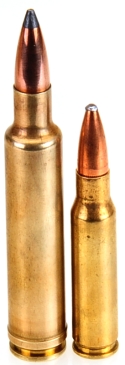
The 338-378 Weatherby Magnum is a huge cartridge, by any small arms definition. Originally considered by Weatherby as a response to the .338 Winchester Magnum as the .340/378 Weatherby, there was not a powder selection that could effectively use the cartridge’s 137 grain capacity. The 340 Weatherby Magnum, a necked up 300 Weatherby Magnum, was released in 1962 and the 338-378 Weatherby Magnum design was shelved until 1998*.
Factory ammunition prices for the .338-378 Weatherby Magnum are not for the faint of heart at $138 – $162 for ammo from two primary brands, Weatherby and Nosler. Real Guns® began reloading the 338-378 Weatherby Magnum for the shop’s Weatherby Accumark in early 1999. Dies were not available initially, so we began with set of custom CH4D dies until we were able to obtain an RCBS production set. Powder selection was initially IMR 7828, H1000, RL 22, and H870. Eventually we moved to RL 25, RL 50 and RS Magnum, selection dependant upon bullet weight and shooting application.
The 338-378 Weatherby is very straight forward to reload, so special steps, no constantly flowing brass that requires lots of trimming. Brass life is actually good at ten conservative uses per piece as long as brass is annealed every other cycle of reloading. Without annealing, cases ring like a bell after two uses. Typical handloads cost less than $20 per box with good bullets, $30 with exceptional hunting bullets.
I was able to work up some handloads with the Weatherby Mark V TRR RC and they are includes in Part 2, along with some live fire observations. Some of the more accurate performers in that group are a 200 grain @ 3,395 fps and held 1 1/2″ at 200 yards, a 215 grain @ 3,201 fps under 1 3/4″ at 200 yards and a 250 grain @ 3,069 fps that shot just a tad over 1″ at the same distance. I’ll be back shortly with Part 2.
*Wildcat Cartridges II – The 338-378 Weatherby Magnum – John Donnelly & The Biggest .338 – Bob Hagel

Email Notification